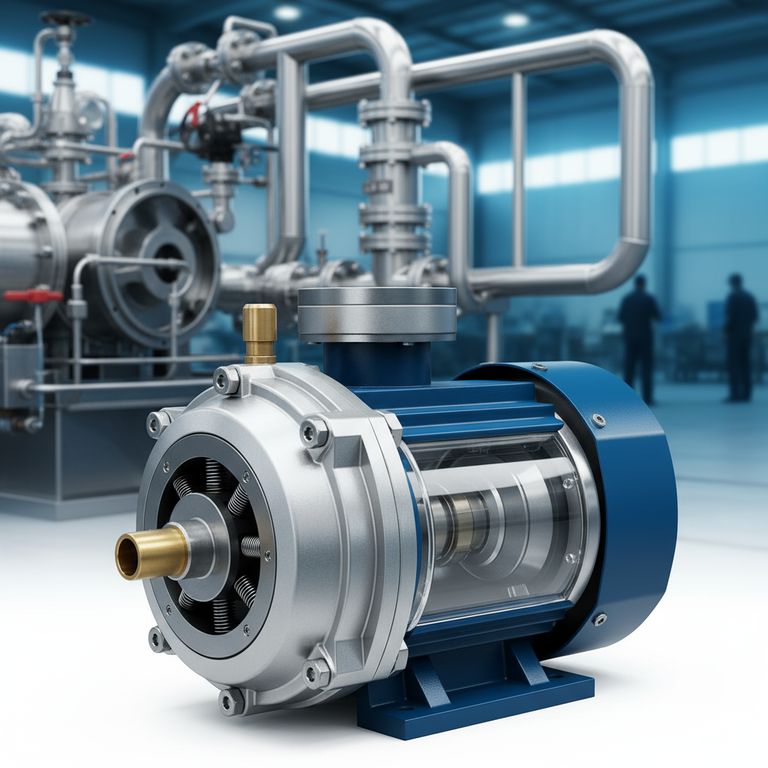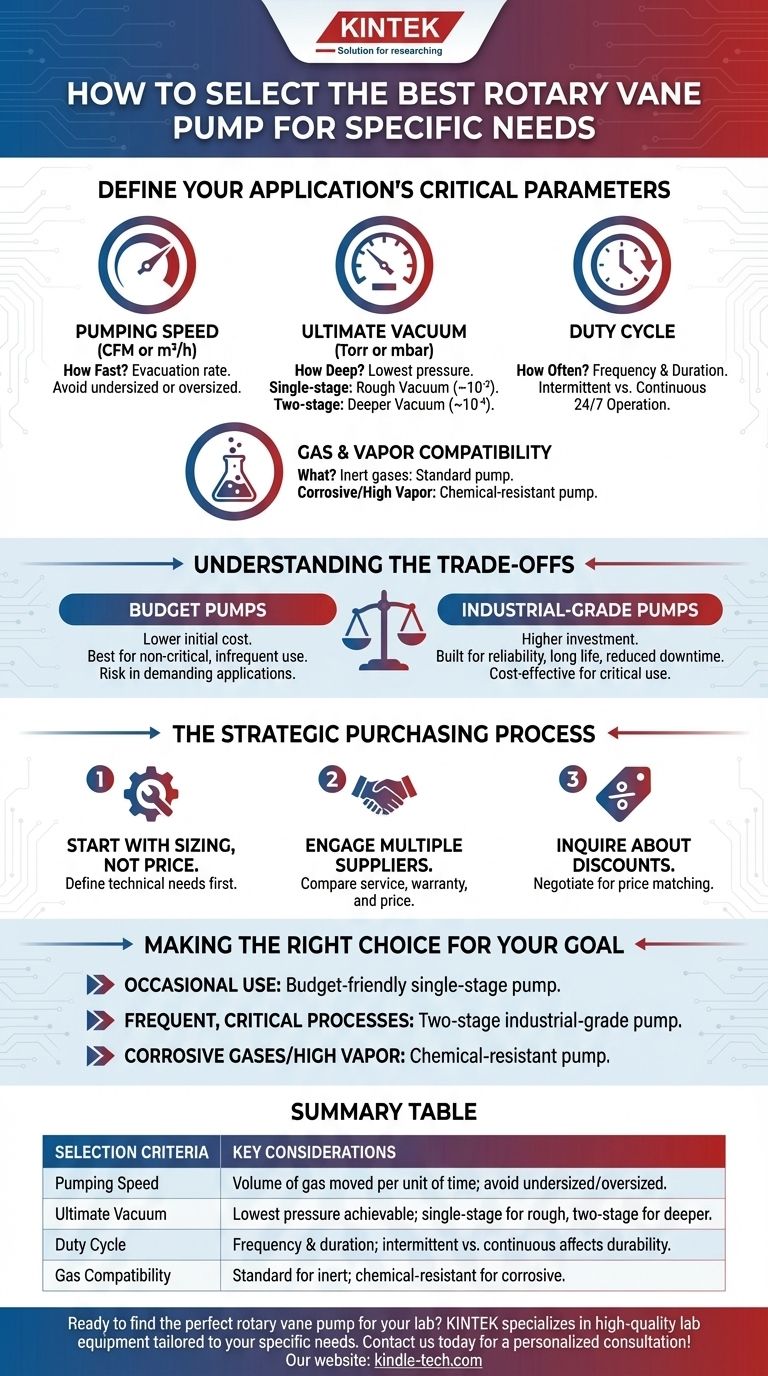To select the best rotary vane pump, you must first define three critical parameters for your application: the required ultimate vacuum level, the necessary pumping speed, and the expected duty cycle. For light, intermittent use requiring only a rough vacuum, a budget-friendly, single-stage pump may be adequate. However, for continuous operation or processes needing a deeper vacuum, a robust, industrial-grade two-stage pump is the correct choice to ensure reliability and longevity.
The most common mistake is choosing a pump based on price alone. The correct approach is to first define your technical needs—how deep, how fast, and how often—and then find the most cost-effective pump that meets those non-negotiable requirements.

Deconstructing Your Application's Needs
A rotary vane pump is not a one-size-fits-all tool. Its performance is defined by specific technical capabilities. Matching these to your application is the single most important step in the selection process.
Pumping Speed (CFM or m³/h): The "How Fast" Factor
Pumping speed, or displacement, measures the volume of gas the pump can move per unit of time when there is no pressure difference. It dictates how quickly you can evacuate a chamber.
An undersized pump will lead to excessively long pump-down times, hindering your process. Conversely, an oversized pump is an unnecessary expense in both initial cost and energy consumption.
Ultimate Vacuum (Torr or mbar): The "How Deep" Factor
Ultimate vacuum is the lowest pressure a pump can achieve in a sealed system. This is the most critical specification for many scientific and industrial processes.
Rotary vane pumps are generally split into two categories based on this metric:
- Single-Stage Pumps: These are simpler, more economical, and ideal for applications requiring only a rough vacuum (e.g., down to ~10⁻² Torr).
- Two-Stage Pumps: These use a second, internal pumping stage to achieve a deeper vacuum (e.g., down to ~10⁻⁴ Torr), making them necessary for processes like freeze-drying, mass spectrometry, or electron microscopy.
Duty Cycle: The "How Often" Factor
The duty cycle refers to how frequently and for how long the pump will operate. This directly impacts the required build quality and thermal management of the pump.
For light, intermittent use, such as 10-15 minutes per hour, a less expensive pump may suffice. For continuous, 24/7 industrial operation, you must invest in a heavy-duty model designed for constant use to prevent overheating and premature failure.
Gas and Vapor Compatibility: The "What" Factor
Standard rotary vane pumps are designed to handle air and other inert gases. If your process involves corrosive chemicals, solvents, or high water vapor loads, you will destroy a standard pump quickly.
In these cases, you must select a chemical-resistant or "corrosion-resistant" model. These pumps feature specialized seals (e.g., FFKM) and internal coatings to withstand aggressive vapors.
Understanding the Trade-offs
Choosing a pump involves balancing initial cost against long-term reliability and total cost of ownership. Understanding the compromises is key to making a wise investment.
The Allure of Budget Pumps
Lower-cost pumps have a clear role for hobbyists, repair shops, or labs with non-critical, infrequent vacuum needs. Their lower initial price is their main advantage.
However, using a budget pump in a demanding or continuous application is a false economy. The risk of unexpected failure, process contamination, and frequent replacement often outweighs the initial savings.
The Case for Industrial-Grade Pumps
High-end pumps from specialized manufacturers are built for reliability. They feature superior materials, better thermal management, and tighter manufacturing tolerances.
While the initial investment is higher, their long service life and reduced downtime make them more cost-effective for any critical or continuous-use application.
The Strategic Purchasing Process
Approaching the purchase strategically can save you money and ensure you get the right equipment for the job.
Start with Sizing, Not Price
Before contacting any suppliers, clearly define your requirements for pumping speed, ultimate vacuum, duty cycle, and gas compatibility. This empowers you to have a technical conversation, not a sales negotiation.
Engage Multiple Suppliers
Once your specifications are set, contact multiple reputable suppliers. This process, similar to buying a car, allows you to compare not just price but also service, warranty, and availability.
Inquire About Price Matching and Discounts
Don't be afraid to negotiate. Suppliers can often offer discounts of 10-20% off the list price. In some cases, a supplier may be willing to match the price of a lower-end model with a superior pump to win your business.
Making the Right Choice for Your Goal
Your final decision should be guided by the primary goal of your application.
- If your primary focus is occasional lab or hobby use: A properly sized, single-stage pump from a reputable budget-friendly brand is often sufficient.
- If your primary focus is frequent, critical processes: Invest in a two-stage, industrial-grade pump from a specialized manufacturer to ensure maximum uptime and reliability.
- If your primary focus is handling corrosive gases or high vapor loads: Prioritize a chemical-resistant pump specifically designed for your process materials, as this is non-negotiable for pump survival.
By focusing on these core principles, you transform the selection from a guess into a calculated decision that ensures your pump is a reliable asset, not a liability.
Summary Table:
| Selection Criteria | Key Considerations |
|---|---|
| Pumping Speed | Volume of gas moved per unit of time (CFM or m³/h); avoid undersized or oversized pumps. |
| Ultimate Vacuum | Lowest pressure achievable (Torr or mbar); single-stage for rough vacuum, two-stage for deeper vacuum. |
| Duty Cycle | Frequency and duration of use; intermittent vs. continuous operation affects pump durability. |
| Gas Compatibility | Standard pumps for inert gases; chemical-resistant models for corrosive vapors or solvents. |
Ready to find the perfect rotary vane pump for your lab? KINTEK specializes in high-quality lab equipment, including rotary vane pumps tailored to your specific needs—whether for light-duty applications or demanding industrial processes. Our experts will help you select a pump that ensures reliability, efficiency, and long-term value. Contact us today for a personalized consultation!
Visual Guide

Related Products
- Laboratory Rotary Vane Vacuum Pump for Lab Use
- Circulating Water Vacuum Pump for Laboratory and Industrial Use
- Oil Free Diaphragm Vacuum Pump for Laboratory and Industrial Use
- Electric Heated Hydraulic Vacuum Heat Press for Lab
- 30T 40T Split Automatic Heated Hydraulic Press Machine with Heated Plates for Laboratory Hot Press
People Also Ask
- What are the safety issues with vacuum pumps? Avoid Chemical, Mechanical, and Implosion Risks
- What is the purpose of the compression chamber in a vacuum pump? The Heart of Vacuum Generation
- How do rotary vane pumps compare to liquid ring vacuum pumps? Choosing the Right Vacuum Pump for Your Process
- How do you inspect a vacuum pump? A Step-by-Step Guide to Ensure Peak Performance
- What are the disadvantages of rotary vane vacuum pumps? Understand the Oil-Related Trade-offs



















